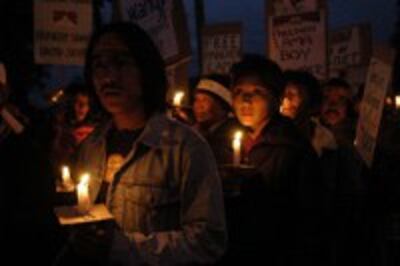Dreaming Lhasa
Dreaming Lhasa

The life of Tibetan refugees in India has focused for more than 40 years on themes of national identity and cultural preservation. Now, husband-and-wife filmmaking team Ritu Sarin and Tenzing Sonam have released a dramatic feature film that addresses these issues.
Dreaming Lhasa, a 90-minute production by White Crane films, premiered at the Toronto Film Festival in late 2005 and has since been shown at festivals around the world.
“What we would really like [now],” writer and co-director Tenzing Sonam said in an interview, “is for the film to get distribution and have a larger audience to play to.”
I think that element of being Tibetan, but being perceived not to be Tibetan by other Tibetans, and not being sure yourself of your own identity—I think that’s very common,
Dreaming Lhasa
Producer and co-director Ritu Sarin added, “Obviously, we want to reach a wider audience...We feel very passionately about the subject.”
Uncertain identity
Dreaming Lhasa tells the story of a young Tibetan-American woman named Karma who comes to the north Indian hilltown of Dharamsala, home of the exiled Dalai Lama, to film interviews with former Tibetan political prisoners—victims of torture at the hands of Chinese police.
Though Karma wants to help her people, she is uncertain of her own identity. Younger Tibetans in particular view her as a foreigner.

“I think that element of being Tibetan, but being perceived not to be Tibetan by other Tibetans, and not being sure yourself of your own identity—I think that’s very common,” Tenzing Sonam said.
In Dharamsala, Karma also finds herself drawn to Dhondup, a former monk who has recently left Tibet to fulfill his mother’s dying wish: that he return a sacred charm box to its owner, a Tibetan man who had earlier escaped to India and vanished there.
Karma joins Dhondup on his quest.
“The reason why she is so attracted to Dhondup,” Sonam said, “is really because he is a Tibetan from Tibet who worked against the Chinese. So in her mind, he is the real Tibetan.”

Sarin said she and Tenzing Sonam lived in Dharamsala for about six years before shooting their film there. “So we had excellent relations in town. And people were very, very excited about a project about their community,” she said.
Traffic often had to be stopped on the roads in and out of town so that they could film, she added.
Sarin and her husband had previously made documentary films on Tibetan subjects, she said. Dreaming Lhasa is their first feature film.
Inertia of refugee life
“It was quite a complex job, because it was a sound film, which means basically that we were shooting the film and the sound at the same time. And this is commonplace in the West, but in India it’s rare to do a sound shoot, especially when we’re shooting on location.”

The film features nonprofessional actors, including—in the starring role as Karma—Tenzin Chokyi Gyatso, a young Tibetan-American woman who auditioned for the role while working at a bank outside Washington D.C.
Jampa Kalsang, playing Dhondup, had previously appeared in the films Windhorse and Samsara.
The inertia of refugee life is examined in detail in Dreaming Lhasa and is a recurring theme of the film. A central character, Jigme, played by Tenzin Jigme, attaches himself to Karma and is shown wasting long hours with friends in pool-halls and bars.
Sonam said that Jigme represents “a lost generation of young Tibetans.”

“There is a small segment that is doing its best for Tibet. But by and large, people are directionless. They want to do something, but they don’t know what to do. So they are frustrated and confused.”
Sonam said his and Sarin’s hope for their film is that it will cause Tibetan refugees “to take stock, to stop and think about who we are at this point in time.”
He added that the film should remind Tibetans of their recent past, “that we had people who sacrificed their lives, and who fought for Tibet.”
“You know, it was a freedom struggle, and younger people shouldn’t forget that, because actually people have forgotten it.”
Original reporting by Richard Finney. Edited for the Web by Sarah Jackson-Han.
